During my holiday in Spain, I
took a lot of photographs.
If one would skim through over 800 photographs I've taken from this trip,
he will probably say, that they look inconsistent and without theme.
In one sense, such a claim will be justified, for there is a photograph of a man using a mobile phone in a street,
a photograph of a dog, children playing in the fountain and a photographs of street signs and buildings.
Indeed they do look inconsistent.
However, for the whole duration of my trip, I was concious about the works of four great documentary photographers:
Eugene Atget, Helen Levitt, Berenice Abbott and Henri Cartier-Bresson.
Before departing to Madrid, I've researched the works of the above four photographers in order to emulate some of their photographic techniques and skills.
Here are the examples of the photographs I was inspired by:
Eugene Atget
1. The Organ-Grinder and the Singing Girl
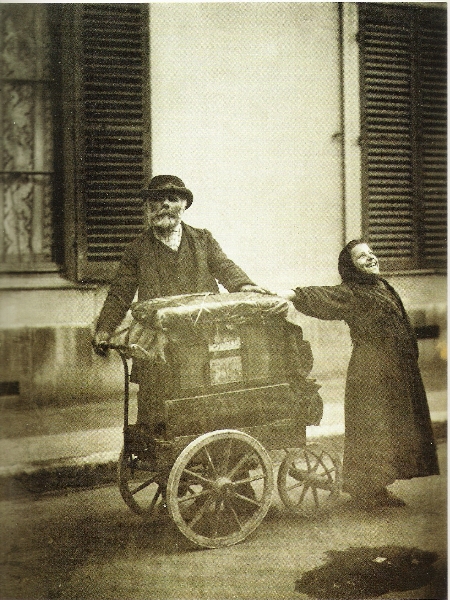
This photograph was taken by Eugene Atget (1857-1927) in Paris at the end of the 19th century. Like many artists lived in this period, the works of Eugene Atget
were not recognised by the general public durign his lifetime but they were later 'discovered' and promoted by Bernice Abbott, an American documentary
photographer (who is introduced below). Eugene Atget worked under the French authority who commissioned him to 'record anything that was left that had
any architectural substance', and left many photographs taken in Paris. His photographic interest varied from architecture, urban environment to
the lives of ordinary people, such as the one shown above.
Comment on the photograph
The facial expressions of the two people in this picture, of a man and a girl are very contrasting. The girl is singing with a beam of happiness, enjoying
her work as a young singer. In contrast, the face of a man, perhpas her father, looks grim. It shows that the man knows the hardship of living, difficulty
of making money and perhaps the cruelty of social injustice. Their clothe look old and worn, indicating that they belong to the low class of the society.
The puddle shown on the bottom right corner is effective in emphasising the two characters poor condition. The overall image of the photograph
summarises the difficulty of the lives of many working class people living in this period in Paris.
Application to my trip
I will focus on the everyday lives of the native Spanish people and will try to take a photograph that represent in microcosm the lives of the people
in modern Spain.
Bernice Abbott
2. Designer's Window
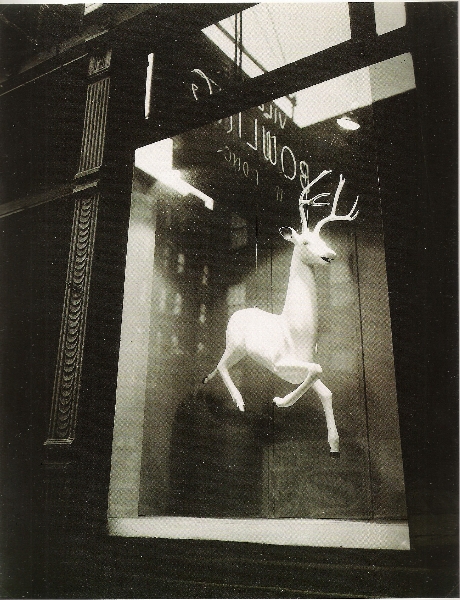
Berenice Abbott (1898-1991) was born in Ohio USA. She is famous for her documentary photographs of the New York city, where she taught photography
for more than twenty years. In her early days, she studied photography in New York as well as in Paris during which she discovered a talent of city photography.
Comment on the photograph
Berenice Abbott is extremely good at finding small things that people often tend to overlook, such as raindeer in a show window as shown above. The photograph,
taken in the New York city, is left with many traces of the characteristic of the city. For example, the reflection on the window which shows the room
lights of an apartment standing opposite, or the electronic sign above the raindeer, which reads 'BOWLING'. The serene look of a raindeer
describes well how she viewed this city.
Application to my trip
There are many things to learn from Abbott's photographs, one of them is her focus on the details. Looking at Abbott's photographs, they show evidence
of her skills to realise small objects or events that describes the overall atmosphere of the city.
Henri Cartier-Bresson
3. 4.
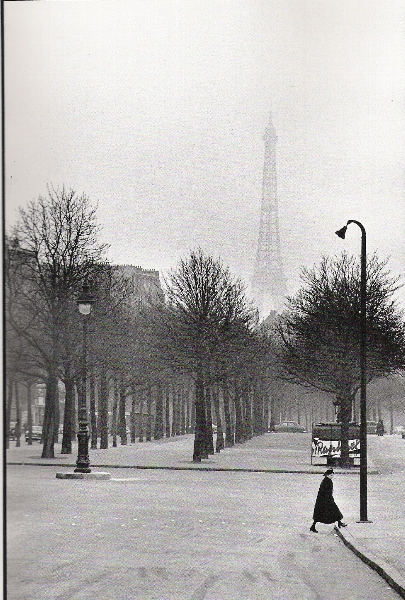
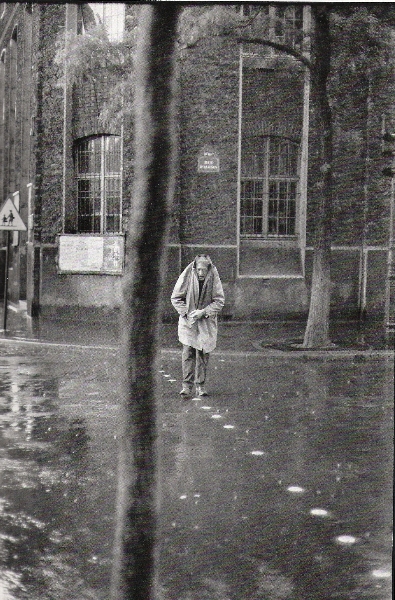
Henri Cartier-Bresson (1908-) was born in France and started his artistic career as a painter, having studied in Paris in his youth. He began his career as a
photographer from the age of 23.
Comment on the photographs
Both photographs shows a person walking across a street. With the skills of Cartier-Bresson, this ordinary topic is turned into an amazingly interesting subject.
The timing of these photographs were very well considered. The photograph on the left, of a woman just finished crossing a silent street, has a very
quirky atmosphere. The photograph prompts the viewer to ask, why there is nobody else around? Who is she? What time of the day is this?
Where in Paris was the picture taken?
The photograph shown on the right, is of a man crossing a street, this time approaching towards the viewer. Cartier-Bresson made this photograph very artistic by
the effective use of a tree which boldly cut through the middle of this photograph, a very interesting composition.
Application to my trip
Timing and composition are the two things I was compelled by his photographs. His photograhs taught me that any ordinary subjects can potentially
become artistic piece of work.
Helen Levitt
5. New York
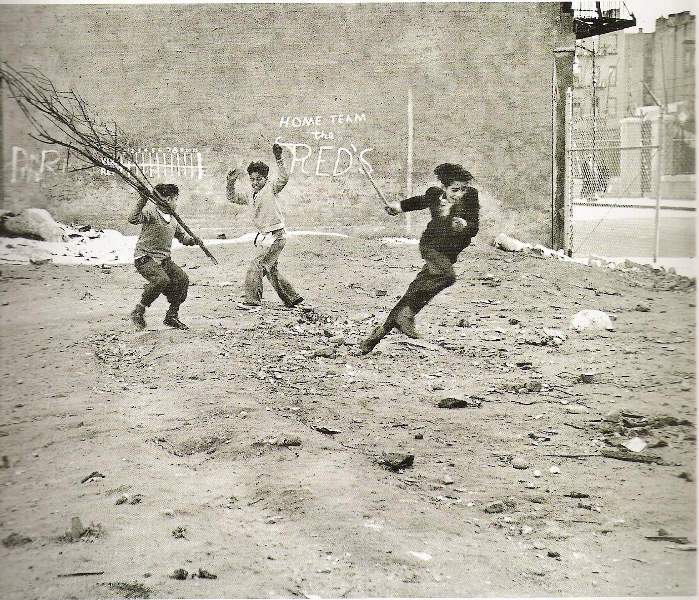
Helen Levitt (1913-) was born in Brooklyn, New York. Her works focus on the lives of ordinary New York citizens, with particular focus on the people
who lived in the poor districts. Her photographs of children are particulary famous..
Comment on the photograph
The expressions on their faces give the viewer a warm feeling and a smile. The graffiti in the background, 'Home Team the REDS', indicates that this place is their
favourite playground and a barely seen scoreboard on the left, hints that this place is used as a baseball ground.
The buildings shown on the right, behind the fences, look derelict and indicates that this is one of the poor districts in New York.
The three boys are in full motion, one running away desperately but with a smile, the two boys on the left fighing each other, not violently, but playfully.
Overall, this photograph brings the viewr back to his youthful days and stirs nostalgia.
Application to my trip
I really like the photographs of children taken by Helen Levitt. I will try to take similar photographs of children that give a warm feeling to the viewer.
Overall comment
The photographs of the above four photographers stir my emotions and make me relate to the photographers' feeling when the photographs were taken.
These photographs make me ask a key question - 'what was the photographer's trying to say?'
Each of the above photographer captures the lives of the people in distinctly identifiable places, with the minimal amount of information on the photograph.
The focus is on people, but the message is attached to the location.
I will take account of these attributes during my trip to Spain.
Back to Top
If one would skim through over 800 photographs I've taken from this trip,
he will probably say, that they look inconsistent and without theme.
In one sense, such a claim will be justified, for there is a photograph of a man using a mobile phone in a street,
a photograph of a dog, children playing in the fountain and a photographs of street signs and buildings.
Indeed they do look inconsistent.
However, for the whole duration of my trip, I was concious about the works of four great documentary photographers:
Eugene Atget, Helen Levitt, Berenice Abbott and Henri Cartier-Bresson.
Before departing to Madrid, I've researched the works of the above four photographers in order to emulate some of their photographic techniques and skills.
Here are the examples of the photographs I was inspired by:
Eugene Atget
1. The Organ-Grinder and the Singing Girl

This photograph was taken by Eugene Atget (1857-1927) in Paris at the end of the 19th century. Like many artists lived in this period, the works of Eugene Atget
were not recognised by the general public durign his lifetime but they were later 'discovered' and promoted by Bernice Abbott, an American documentary
photographer (who is introduced below). Eugene Atget worked under the French authority who commissioned him to 'record anything that was left that had
any architectural substance', and left many photographs taken in Paris. His photographic interest varied from architecture, urban environment to
the lives of ordinary people, such as the one shown above.
Comment on the photograph
The facial expressions of the two people in this picture, of a man and a girl are very contrasting. The girl is singing with a beam of happiness, enjoying
her work as a young singer. In contrast, the face of a man, perhpas her father, looks grim. It shows that the man knows the hardship of living, difficulty
of making money and perhaps the cruelty of social injustice. Their clothe look old and worn, indicating that they belong to the low class of the society.
The puddle shown on the bottom right corner is effective in emphasising the two characters poor condition. The overall image of the photograph
summarises the difficulty of the lives of many working class people living in this period in Paris.
Application to my trip
I will focus on the everyday lives of the native Spanish people and will try to take a photograph that represent in microcosm the lives of the people
in modern Spain.
Bernice Abbott
2. Designer's Window

Berenice Abbott (1898-1991) was born in Ohio USA. She is famous for her documentary photographs of the New York city, where she taught photography
for more than twenty years. In her early days, she studied photography in New York as well as in Paris during which she discovered a talent of city photography.
Comment on the photograph
Berenice Abbott is extremely good at finding small things that people often tend to overlook, such as raindeer in a show window as shown above. The photograph,
taken in the New York city, is left with many traces of the characteristic of the city. For example, the reflection on the window which shows the room
lights of an apartment standing opposite, or the electronic sign above the raindeer, which reads 'BOWLING'. The serene look of a raindeer
describes well how she viewed this city.
Application to my trip
There are many things to learn from Abbott's photographs, one of them is her focus on the details. Looking at Abbott's photographs, they show evidence
of her skills to realise small objects or events that describes the overall atmosphere of the city.
Henri Cartier-Bresson
3. 4.


Henri Cartier-Bresson (1908-) was born in France and started his artistic career as a painter, having studied in Paris in his youth. He began his career as a
photographer from the age of 23.
Comment on the photographs
Both photographs shows a person walking across a street. With the skills of Cartier-Bresson, this ordinary topic is turned into an amazingly interesting subject.
The timing of these photographs were very well considered. The photograph on the left, of a woman just finished crossing a silent street, has a very
quirky atmosphere. The photograph prompts the viewer to ask, why there is nobody else around? Who is she? What time of the day is this?
Where in Paris was the picture taken?
The photograph shown on the right, is of a man crossing a street, this time approaching towards the viewer. Cartier-Bresson made this photograph very artistic by
the effective use of a tree which boldly cut through the middle of this photograph, a very interesting composition.
Application to my trip
Timing and composition are the two things I was compelled by his photographs. His photograhs taught me that any ordinary subjects can potentially
become artistic piece of work.
Helen Levitt
5. New York

Helen Levitt (1913-) was born in Brooklyn, New York. Her works focus on the lives of ordinary New York citizens, with particular focus on the people
who lived in the poor districts. Her photographs of children are particulary famous..
Comment on the photograph
The expressions on their faces give the viewer a warm feeling and a smile. The graffiti in the background, 'Home Team the REDS', indicates that this place is their
favourite playground and a barely seen scoreboard on the left, hints that this place is used as a baseball ground.
The buildings shown on the right, behind the fences, look derelict and indicates that this is one of the poor districts in New York.
The three boys are in full motion, one running away desperately but with a smile, the two boys on the left fighing each other, not violently, but playfully.
Overall, this photograph brings the viewr back to his youthful days and stirs nostalgia.
Application to my trip
I really like the photographs of children taken by Helen Levitt. I will try to take similar photographs of children that give a warm feeling to the viewer.
Overall comment
The photographs of the above four photographers stir my emotions and make me relate to the photographers' feeling when the photographs were taken.
These photographs make me ask a key question - 'what was the photographer's trying to say?'
Each of the above photographer captures the lives of the people in distinctly identifiable places, with the minimal amount of information on the photograph.
The focus is on people, but the message is attached to the location.
I will take account of these attributes during my trip to Spain.
Back to Top